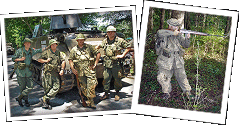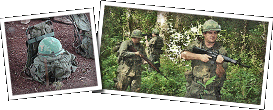Tips That Will Save Your Life
from Professional Knowledge Gained from Operational Experience in Vietnam, 1967
When a unit moves into a new area, it is unlikely to encounter booby traps. However, if the unit leaves and then returns a few hours later, it is a good idea to conduct a thorough search for mines and booby traps. Experience has shown that the VC will have mined the area during the time the unit was away. Remember, it only takes a few minutes to rig a booby trap.
Whenever cutting wires leading to an electrically rigged charge, cut the wires one at a time. If both wires are cut together there is a good possibility of activating the device.
Interrogation by experienced Marines establishes the fact that the VC mark most mines and booby traps. The marker will normally be 200 to 400 yards from the device and will vary with the area in which the operations are taking place. It may consist of a piece of cloth, a twig bent in a certain way, a leaf tied in a knot or a pile of stones.
Many booby traps encountered by Marines use theU.S.M-26 fragmentation grenade. The bulk of these grenades have been supplied to the enemy by Marines who insist on carrying them "John Wayne" style on suspenders or in unbuttoned pockets.
Tripwires used by the enemy are often single strand (monofilament) fish line which is very difficult to see and nondetectable by mine detectors.
The enemy often places a booby trap so it will be easily detected. Beware! This is just a ruse to draw you into the area. There is probably another device in the immediate vicinity.
Two boobytrapped mines have been found on a trail which were attached to sticks three feet off the ground. Two wires were attached to each mine; one across the trail and one in the area to the side of the trail which covered any attempt to walk around the mine. Remember, when a trip wire is discovered, look for additional wires!
No road or trail can be considered 100% safe. Not even the road to the PX. Vigilance must be continuously exercised.
Unnecessary casualties have occurred in Vietnam when more than one Marine became involved in the disarming of enemy mines and booby traps. Mines should normally be blown in place. When they must be disarmed, only one Marine should perform the operation except when help is absolutely needed.
The LAAW (M-72) has proven to be a definite asset to the Marine rifle platoon. However, a word of caution. Destroy the expended tube to prevent its use by the enemy or it may return to you in the form of a boobytrapped mine. The enemy is extremely clever at this and takes every opportunity to use items discarded by Marines.
Other items normally discarded by Marines which the Viet Cong use in fabricating explosive devices are:
- Communication wire
- Batteries
- Duds
- Explosives
- Blasting caps
- Plastic waterproofing material
- Ammo boxes
Any Marine who approaches closely to another Marine in the presence of the enemy is doing a disservice to himself and his buddy. In one case, six men were killed and nine wounded in Vietnam by a mine believed to have been command detonated. Excessive casualties from a single explosive device can only be attributed to the tendency to bunch up. Remember, spread out and live!
The Viet Cong technique of placing a booby trapped 81mm round in a tree line approximately five meters .off the ground has paid high dividends for them. On one occasion, a Marine patrol suffered one KIA and six WIA from such a device. The blast and fragmentation effects were comparable to a low airburst.
The enemy has developed two techniques to test the capabilities of Marine mine detectors. One method is to place a metal bolt in a large piece of cactus, or fill a tin can with human waste and bury it. A mine is often attached to these devices in hopes that mine clearance teams will become careless when they discover an apparently harmless piece of metal.
Another technique employed by the enemy is to fill ration cans with metal objects and then bury them at various depths in order to test the effectiveness of Marine mine detectors.
The Viet Cong have the capability of altering the M-26 fragmentation grenade so that it serves as an effective booby trap. The fuze assembly is removed and a nonelectric blasting cap with a 6-penny nail placed in the top is inserted in the fuze well of the grenade. Wax is poured into the grenade fuze well, around the nail and blasting cap to waterproof the device and hold the nail in place. The grenade is then buried upright with the nail protruding above the ground.
A great many enemy mines are the controlled electric detonation type. The lead wire used to detonate the mine is often Marine communication wire. It is, therefore, extremely difficult to distinguish the enemy lead wire from friendly communication lines. Suspect all communication wire!
All communication wire should be placed at least twenty meters from all roadways. This practice will aid in the visual detection of mines electrically detonated from locations off the roadway.
The Viet Cong are employing a special type of homemade grenade which incorporates a firing device actuated by acid. The grenade body is green or red and has a green safety lever. It is designed to explode when the safety lever is touched and is purposely left on the battlefield in hopes that unsuspecting troops will pick it up.
The Viet Cong, on one occasion, laid mines near two ramps which had been constructed to permit LVTs access to a river. The mines were laid out in a triangular pattern. A Marine demolition platoon used six charges to destroy the mines and achieved nine secondary explosions, one of which was a 155mm shell. Remember, when one mine is discovered, check for others!
The Viet Cong use a 10-pound shape charge with markings "MDH over L207.65 over TNT over 210" as a mine. The charge is emplaced along a road and is prepared for controlled electric detonation. Over 100 meters of communication wire is normally used as a lead. In every instance. Marines have discovered these mines by detecting the communication wire and tracing it to the mine.
Take the following actions to avoid contact with mines or minimize the effect of mines on the LVTP-5:
- Sandbag the deck of the cargo compartment.
- Open the hatches to reduce the pressure and diffuse the blast effect as well as to allow quick escape from the vehicle.
- The driver and crew chief of the LVT must continuously make visual inspections of the ground ahead for freshly dug areas, unusual debris, or any unusual change in an area previously traveled.
- When vehicles are in column, ensure that an extended interval is kept between vehicles and that the vehicles track each other. However, do not use the track trace made by vehicles traveling in the area before you arrived.
- Vary the pattern of employment and routes used.
- Avoid narrow routes or defiles.
- If time and conditions permit, employ mine clearance teams.
- Maintain surveillance over routes repeatedly used.
Although countermeasures being taken by the III MAP have reduced the number of casualties caused by mines and booby traps, individual Marines must be constantly on the alert, particularly when physical exhaustion dulls the senses, if casualties are to be further reduced. The enemy is clever and imaginative and is continually devising new methods of employing mines and booby traps. Even handbills and election posters on the sides of trees and buildings have been boobytrapped.
The VC employ mines and booby traps extensively. A system of marking the emplacement of these devices is needed in order to alert their own forces operating in the area. The following methods have been used by the VC to mark the emplacement of their mines and booby traps:
- Stick or bamboo broken at right angles in road or trail indicates mines or booby traps 200/400 meters ahead.
- Three sticks or stones placed across trail indicates trail is unsafe.
- Sign on side of road or trail saying "Chu Min" indicates mines 200/400 meters ahead.
- Sign "Cam" indicates mines or booby traps are in the immediate area or on the trail.
- One to three strings above entrance to house or cave indicates booby traps.
- Tripod of wood about two inches high indicates punji pit, tripod directly over pit.
- Triangle of sticks on trail indicates mines or booby traps in area.
- Stick or length of bamboo along side and
parallel to trail indicates safe for VC.


